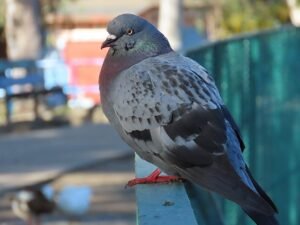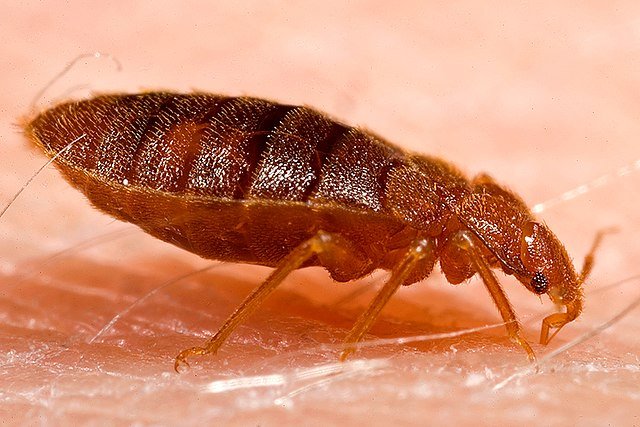Pigeons (Columba livia domestica): Identification, Risks & Control
 City pigeons are expert opportunists. Give them a ledge, a crumb, and a quiet nook, and they’ll gift you guano, blocked gutters, and a chorus of cooing at 5 a.m. Charming? Sometimes. Costly and unsanitary? Often. This guide gets straight to it: how to identify urban pigeons, understand their behavior, assess the risks, and deploy control methods that actually work—at home, at scale, and without drama.
City pigeons are expert opportunists. Give them a ledge, a crumb, and a quiet nook, and they’ll gift you guano, blocked gutters, and a chorus of cooing at 5 a.m. Charming? Sometimes. Costly and unsanitary? Often. This guide gets straight to it: how to identify urban pigeons, understand their behavior, assess the risks, and deploy control methods that actually work—at home, at scale, and without drama.
Why this matters: pigeon activity rarely stays “just birds.” Droppings and nests attract secondary pests like Blow Flies, House Flies, Cluster Flies, and Carpet Beetles, and that multiplies your problem.
Fast ID Snapshot
Common name: Pigeon, feral pigeon, city dove
Scientific name: Columba livia domestica
Size: 30–35 cm; 250–350 g
Look: Blue-gray base, green/purple neck sheen, two dark wing bars; many color morphs (white, brown, pied)
Feet/Eyes: Red feet; orange/red eyes
Behavioral tell: Confident around people, flocking, roosting on flat ledges, under solar panels, bridges, and signage
Biology & Lifecycle (Why They Explode in Number)
Breeding pace: In mild climates, year-round. Typical clutch is 2 eggs, with ~18 days incubation.
Parental care: Both parents feed the chicks (“squabs”) with nutrient-rich crop milk—a secret sauce that accelerates growth.
Fledging: ~4 weeks. Pairs can raise multiple broods annually.
Longevity: 3–5 years wild; much longer in captivity.
Site fidelity: Strong homing instinct. Once they mark your building as “home,” they’ll return unless physically excluded.
Diet: Opportunistic—grains, food waste, spilled feed, pet food; they’ll commute daily between feeding grounds and favored roosts.
Implication for control: If food and ledges remain, numbers rebound. Any plan that skips either variable fails.
Urban Ecology & Daily Pattern
Roosting: High, dry, sheltered ledges that mimic cliffs—parapets, I-beams, signs, HVAC housings, under panels.
Nesting: Niches with a lip and cover. They’ll reuse sites, stacking rough twig “disks” into messy platforms.
Daily rhythm: Morning feed → midday loaf → late-afternoon feed → return to roost.
Seasonality: Winter warm spots (vents, south façades) get crowded; spring brings nesting drives and territorial behavior.
Risks & Problems (No Sugarcoating)
1) Property Damage
Corrosion & staining: Acidic droppings etch stone, metal, coatings, and solar glass; salts wick moisture into masonry.
Blocked drainage: Nests and feathers clog gutters/ downpipes → leaks, damp, interior damage.
Mechanical/electrical faults: Nests in signage, junction boxes, HVAC intakes; debris + guano = shorts, odors, breakdowns.
Solar arrays: Nesting under panels reduces ventilation and efficiency; guano shadows cells and invites Cluster Flies and Carpet Beetles.
2) Health & Hygiene
Pathogens associated with droppings/nests:
Psittacosis (Chlamydia psittaci)—flu-like illness; occupational risk in clean-ups.
Histoplasmosis (fungal spores in accumulations of droppings)—respiratory risk when dust is aerosolized.
Cryptococcosis (fungal) in long-standing deposits.
Opportunistic bacteria (e.g., Salmonella) on contaminated surfaces.
Allergen load: Dried droppings → dust → irritation/asthma triggers during unprotected cleaning.
Secondary pests:
Blow Flies and House Flies breed in carcasses/guano;
Cluster Flies congregate near warm attics;
Carpet Beetles feed on feathers and nest detritus.
Public nuisance: Slip hazards on pavements, smell, noise, aggressive scavenging in outdoor dining zones.
Key point: Pigeons themselves aren’t “walking biohazards,” but their residues and the ecosystems they create definitely are.
How to Diagnose a Pigeon Problem (Early Beats Cheap)
Guano patterns: Fresh splatter below parapets, ledges, signage, sills.
Nesting signs: Twigs, feathers, eggshells in sheltered cavities, under panels, in gutters.
Footprints/“tracking”: Powdery footprints along routes from loafing to nesting ledges.
Noise & presence: Persistent cooing, wing claps at dawn/dusk; sudden daytime flushes from rooftops.
Secondary evidence: Sudden waves of Blow Flies near trash rooms; Carpet Beetle skins near nests.
DIY & Small-Property Control (What Actually Works)
1) Sanitation (Non-Negotiable)
Ban feeding; install signage if needed.
Keep bins closed; bag organic waste; schedule frequent pickups.
Eliminate spilled grain/pet food; clean outdoor dining zones promptly.
2) Exclusion & Deterrence (Hardware Beats Gimmicks)
Netting: Gold standard for voids, canopies, loading bays, balconies, plant rooms.
Choose UV-stable, flame-retardant net; mesh size ~19 mm for pigeons.
Proper tension + perimeter cabling = zero gaps.
Spikes: For linear ledges, signs, pipes; use full-density stainless spikes, bonded or screwed (not sparse “token” rows).
Sloped ledge systems: 45–60° anti-roosting angles defeat flat perches on sills/parapets.
Bird wire/post systems: Low-visibility tensioned lines for decorative stonework.
Electric track (shock): Low-amp deterrent for persistent sites and historic façades where spikes are unsightly.
Vents/Chimneys: Fit proofing grills/caps; secure gaps around AC lines and cable penetrations.
Solar arrays: Fit custom under-panel mesh skirts; no cable pinch points.
Skip the snake-oil: fake owls, loose CDs, or random ultrasound boxes don’t hold up beyond a few days. Birds habituate.
3) Habitat Tweaks
Remove standing water sources; cap planters; adjust irrigation overspray.
Prune dense ivy/creeper from façades that hides nests.
Re-design favored ledges during refurb (add slope caps, break long runs with vertical fins).
4) Cleaning & Safety (Do This Right)
Never dry-sweep droppings. Pre-wet with detergent/disinfectant; allow dwell time; scrape and double-bag.
PPE: Disposable coveralls, gloves, eye protection, and at least an N95/P2 respirator; HEPA vacuums for dust.
Treat nesting sites for insect activity (e.g., Blow Flies, Carpet Beetles) before removal to avoid a fly bloom indoors.
Final rinse + surface sealers on porous stone where appropriate.
Professional & Long-Term Programs (When Scale/Compliance Matters)
1) Site Survey & Pressure Map
Count birds by zone (loafing vs nesting).
Log roosting lines, droppings density, access paths, food/water sources, and neighboring attractants (markets, grain, rooftop gardens).
Classify “pressure”: low (loafing), medium (regular roost), high (active breeding). High pressure demands netting/track, not just spikes.
2) Engineering-First Controls
Netting projects: Custom perimeters, stainless fixings, corner bracing; access zips for maintenance.
Electric track: Continuous runs on sign tops, cornices, coping stones; discrete look for premium façades.
Mixed systems: Spikes on narrow pipes + slope caps on sills + bird wire on ornate ledges → layered defense.
3) Population Management (Where Legal/Ethical)
Contraceptive bait (e.g., nicarbazin-based programs): reduces hatch rates; requires strict daily baiting and monitoring.
Loft/trap & remove: Pigeon lofts that replace ad-hoc nesting; eggs swapped/reduced under permit.
Culling: Regulated and restricted in many regions; optics and ethics matter. Always check law.
4) Operations, KPIs & Documentation
Service schedule matched to breeding cycles.
KPIs: new nest counts, droppings per linear meter, customer sightings.
Photo logs, access plans, and safety documentation for roofs, lifts, MEWPs.
5) Special Sites
Hospitals/Food plants: Zero-tolerance perimeters, ingress audits, and roof proofing; strict hygiene protocols for guano removal.
Heritage buildings: Reversible, minimally visible systems (wire, track, color-matched netting).
Solar farms/rooftop PV: Under-panel proofing + cleaning schedule; protect cable trays.
What Doesn’t Work (Save Your Money)
Short-term scare devices without structural change.
Partial spikes on a long ledge (they roost between rows).
Paint-on sticky gels in high-dust areas (they gum up and collect dirt).
One-off cleans without exclusion (birds re-establish in days).
Small Balcony Playbook (Step-by-Step)
Remove nests (treat for Blow Flies first), bag waste, pre-wet/clean with PPE.
Install netting across the opening; use corner plates + cable + turnbuckles; tension tight.
Spike the top rail and AC unit; mesh any side gaps > 25 mm.
Seal cable penetrations/weep holes bigger than a thumb.
Keep it clean: no food, no standing water, no soft planters as nest sites.
Legal & Ethical Notes (Don’t Get Fined)
Wildlife laws differ by country/region. Feral pigeons are often controllable, but methods (trapping, culling, nest/egg removal) may require permits.
Nesting with active chicks can trigger extra restrictions—don’t remove without checking.
Humane standards matter: use approved devices, trained installers, and avoid entanglement hazards in netting.
Costs & ROI (Prevention is Cheaper Than Guano)
Reactive cleaning is endless (and expensive).
One solid install—netting for hotspots + spikes/track for lines—pays back in fewer cleans, fewer complaints, less corrosion, and better hygiene scores.
Related Insects You’ll Likely See Around Pigeons
To interlink only what’s truly relevant from your site: Blow Flies, House Flies, Cluster Flies, Carpet Beetles.
Advanced Control Strategies
Optical Gel and Repellent Gels: Specialized products that make ledges visually and physically unattractive to pigeons.
Shock Tracks: Deliver mild electric pulses to discourage landing without harming the birds.
Falconry and Predator Decoys: Used in airports and large facilities, trained birds of prey or realistic predator models can deter pigeon flocks.
Genetic Control Research: Emerging studies explore fertility reduction through treated feed, though regulatory approval varies.
Comparative Note: Pigeons vs Other Urban Pests
Pigeons: Cause structural damage and disease spread through droppings.
House Sparrows (Passer domesticus): Compete for nesting spaces but usually at smaller scales.
Blow Flies (Calliphoridae): Exploit pigeon carcasses and droppings, linking bird infestations to secondary insect issues.
Bed Bugs (Cimex lectularius): Sometimes infest pigeon nests, creating pathways to human living areas.
FAQs About Pigeons
Q: Are pigeons dangerous to human health?
A: Yes. Their droppings can carry pathogens like Histoplasma capsulatum and Cryptococcus neoformans. Risk is highest in enclosed, poorly ventilated areas.
Q: Can pigeons spread parasites?
A: Absolutely. Mites and ticks associated with pigeon nests can migrate indoors, sometimes mistaken for Fleas (Siphonaptera).
Q: Why do pigeons always return “home”?
A: Pigeons have a strong homing instinct. They can navigate long distances using magnetic fields, the sun, and visual landmarks.
Q: Do spikes and nets really work?
A: Yes—when installed properly. Poor installation often leaves gaps pigeons exploit.
Q: Are pigeons protected by law?
A: In most regions, feral pigeons (Columba livia domestica) are not protected, but local laws may regulate methods of control. Always check regional wildlife legislation.
Urban Ecology and Human Responsibility
Cities created the perfect niche for pigeons: abundant food, high-rise cliffs (buildings), and year-round shelter. Unlike pests such as Fruit Flies (Drosophila melanogaster), which depend on kitchen waste, pigeons thrive on human food subsidies in public spaces.
Effective management, therefore, is less about extermination and more about urban design and public behavior. Without controlling food sources (litter, intentional feeding), pigeon control is short-lived.
Final Thoughts
Pigeons are a paradox of the urban landscape. On one hand, they are symbols of peace and companionship; on the other, they are resilient pests that adapt to nearly every environment humans create. While they don’t chew wires like rodents or feed on stored foods like Cockroaches (Blattella germanica) or Flour Beetles (Tribolium spp.), their droppings, nesting the mites they carry, and potential disease transmission make them a unique management challenge.
The key takeaway: pigeons are not “dirty by nature” but rather opportunistic survivors. Controlling them requires strategy, prevention, and persistence—not panic.
Disclaimer
This article is for informational purposes only. Pest control laws and approved methods vary by country. For best results and legal compliance, always consult a licensed pest control professional in your area. Ensure that control strategies are humane and permitted under local wildlife regulations.
Author
Nasos Iliopoulos
MSc Agronomist & Certified Pest Control Expert
Scientific Director, Advance Services (Athens, Greece)
Licensed Pest Control Business – Ministry of Rural Development & Food (GR)
References
British Pest Control Association (BPCA) – Guidance on Bird Management
Wikipedia – Birds control
Wikipedia – Pigeons

